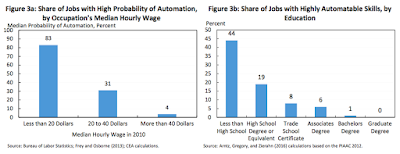1. The Executive Office of the US President has an excellent report on how technological changes affect the labor market, “Artificial Intelligence, Automation, and the Economy”.
It has recommended a slew of policies - raising the minimum wage, strengthening union bargaining power, providing cheaper housing to improve labour mobility, shifting taxes from labour to capital, and massively increasing funding for job training and re-education. It identifies three broad categories of policies to address this - invest in and develop AI for its many benefits; educate and train Americans for jobs of the future; and aid workers in the transition and empower workers to ensure broadly shared growth.
Because AI is not a single technology, but rather a collection of technologies that are applied to specific tasks, the effects of AI will be felt unevenly through the economy. Some tasks will be more easily automated than others, and some jobs will be affected more than others—both negatively and positively. Some jobs may be automated away, while for others, AI-driven automation will make many workers more productive and increase demand for certain skills. Finally, new jobs are likely to be directly created in areas such as the development and supervision of AI as well as indirectly created in a range of areas throughout the economy as higher incomes lead to expanded demand... Research consistently finds that the jobs that are threatened by automation are highly concentrated among lower-paid, lower-skilled, and less-educated workers. This means that automation will continue to put downward pressure on demand for this group, putting downward pressure on wages and upward pressure on inequality.
2. Carl Benedikt Frey and Michael Osborne have an assessment of the total share of jobs in different countries which are at "high risk" from automation. They find that the share of jobs at risk increases with decreasing per capita incomes, and the share for India and China stood at 69% and 77% respectively.
Techno-optimists like Erik Brynjolfsson and Andrew Mcafee argue that such automation will be accompanied by the creation of newer categories of jobs. While that is entirely likely, the concern is that those newer jobs may be only a small proportion of the jobs that have been destroyed or displaced. The concern arises from the fact that manufacturing - which has been the single biggest category of productive jobs, with clear pathway of gradual labor market mobility, across countries which have traversed the development trajectory - would be the worst affected by automation.
In any case, automation is not the only challenge facing labor today. In the years ahead, labor markets across the world, including developed economies, will have to navigate four headwinds in the years ahead - premature de-industrialization, stagnating global trade, rising automation, and the declining influence of the multinational corporation. None of the current thinking provides a satisfactory enough answer to addressing them.


1 comment:
The link for the report on AI is to be updated (archived): https://obamawhitehouse.archives.gov/sites/whitehouse.gov/files/documents/Artificial-Intelligence-Automation-Economy.PDF
Post a Comment